 |
|
Vol. 19, No. 11, SEPTEMBER 12, 2006 |
|
| THE FRIDAY PROGRAM: The Myths of Technology Change (Bob Seidensticker) | Friday Potpourri | Walk-A-Thon Needs Help | Directory Photo Shoot | Bob Bowen's Classification Talk | Paul Harris Fellows | The Importance of Clean Water | Sayoko & Laura Bush | We Get Emails: Brian Heimbigner | Web Fun | |
Friday's Program:
Future Hype: The Myths of Technology Changes There are nine myths in the book, we will look at three today. Myth one: Technology is changing exponentially. This is a widespread idea, but it has been true for centuries. Take airplanes from bi-planes to jets in a matter of a few years. We travel today at the same rate we did 50 years ago. Skyscrapers, printing press. America is addicted to fossil fuel. Fuel cell 1839, battery 1799, solar cell. The point is: technology changes no faster today than it has since the industrial revolution. Myth two: Technology is inevitable. Most technology flops. Today we have the phone, tomorrow we will have video phones; today we predict the weather, tomorrow we will control it. The next shiny new technology is not inevitable. “Whenever you get the urge to predict the future, you had better lie down until it goes away.” — Forbes This is not an academic issue. Myth three: Todays technology is so impressive, it ellipses all.
In 1815, Battle of New Orleans, the war was over, the treaty had been signed, but the battle was still being fought because they didn’t know the war was over, because it took a long time for a boat with a messenger to get to new Orleans. It was the worst defeat the British had. The telegraph changed how quickly information could be sent out. Does a PC that runs twice as fast make you twice as productive? No. But, does a truck that can haul twice as much make you twice as productive? Yes. Technologys hidden costs: it appears a laptop costs about $500 a year, but we forget to include the software upgrades, downtime, training time and other associated costs. Businesses spend $2.7 billion on information technology every year. The wild wild internet: >50% of email is spam.
Suggested guidelines for being a smart technology consumer: 1. Be skeptical; look for the hype. • • • Click here to view the Powerpoint presentation from Bob Seidensticker's program. 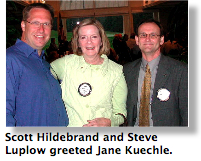
Steve Luplow gave the invocation and pledge. Scott Hildebrand welcomed guests and visiting Rotarians. Up first was Belinda Kennedy from Scotland. She was excited to be visiting the BBRC, as her club is a small club of 24 people. There were a total of 4 visiting Rotarians and 3 guests. Dick Brown also thanked everyone for sending Don Deasy cards. Bob Bowen’s Classification Talk
Bob is a fifth generation Chinese American, originally from the Bay area. He has a degree in psychology and social services. Bob has had opportunities to travel, and everywhere he went, he saw the big signs for WorldVision. His goal was to someday work for WV. Seven years ago Bob took a plunge to become a minister; then two years ago, he had the opportunity to go to work for WV. Many people say the best thing about Bob is his wife Janice. They have two adopted boys, the first from Korea, the second locally. Many people know Bob from baseball. His proudest moment was starting the Challenger Teams, baseball teams for youth with disabilities. Imagine a kid in a wheelchair having the opportunity to play baseball. As a Chaplain, Bob left us with this thought: “Monday, we celebrate the anniversary of a very tragic event in our history. There are men and women in uniform protecting us from far away, others protecting us close at home in neighborhoods. Please take a moment on Monday to thank all of those people who have served us so well.”
It is now time to recognize some of our fellow members. Morris Kremin, thank you for your donation to the Foundation. After you have given $2,000, you are awarded with a pin with a sapphire in it. Tom Smith, congratulations on your sapphire pin. Jim Zidar received a pin with two sapphires representing a donation of $3,000.
Jim learned about Rotary as a platoon leader in Vietnam. The Army had a program that had Jim working with one of the local leaders for a year. Troung was 26, Jim was 24, many similarities between them. Both were married with kids; Troung, 6 kids, Jim, a new baby he had not yet met. During that year, Troung lost three of his children to dysentery. It was nothing Jim had ever thought about. This is where Jim learned about the importance of clean water. Dysentery is a major problem, a huge statistic. Sometimes that is what it is, just a statistic. But for Rotary, it is not just a statistic, it is something we take action on. Clean water around the world is one of the projects the Rotary Foundation works on. We Get Emails: Brian Heimbigner Here are some excerpts from an email fromformer member Brian Heimbigner to John Mix:
CHRISTMAS CAROLS FOR THE MENTALLY CHALLENGED NOTE FROM JOHN: SCHIZOPHRENIA MULTIPLE PERSONALITY DISORDER DEMENTIA NARCISSISTIC MANIC PARANOID PERSONALITY DISORDER DEPRESSION OBSESSIVE-COMPULSIVE DISORDER PASSIVE-AGGRESSIVE PERSONALITY BORDERLINE PERSONALITY DISORDER
|
|
|

 Jenny Andrews announced that here are several committees for the Walk-A-Thon which still need help. Please contact one of the committee chairpersons below to sign up:
Jenny Andrews announced that here are several committees for the Walk-A-Thon which still need help. Please contact one of the committee chairpersons below to sign up: Larry will be set up from 6:45AM till about 7:10AM. If you don't have a photo in the online Directory, or if you would like to update your photo, show up a little early for the meeting on September 29, and get your picture taken then!
Larry will be set up from 6:45AM till about 7:10AM. If you don't have a photo in the online Directory, or if you would like to update your photo, show up a little early for the meeting on September 29, and get your picture taken then! 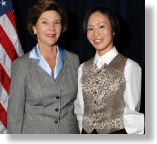

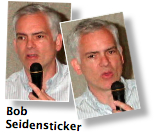
 E-commerce in 2004 was worth 7 billion dollars, only 2% of all retail sales. Keep it in perspective. The transcontinental railroad of the 1870s and catalogs allow people to buy things like never before. Before email, we had phone and mail. The internet changes everything, so has nuclear power.
E-commerce in 2004 was worth 7 billion dollars, only 2% of all retail sales. Keep it in perspective. The transcontinental railroad of the 1870s and catalogs allow people to buy things like never before. Before email, we had phone and mail. The internet changes everything, so has nuclear power. 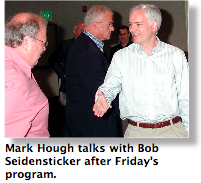 Stress is an expense. Does 24/7 access allow you to be connected to the office? Or, make you connected to the office?
Stress is an expense. Does 24/7 access allow you to be connected to the office? Or, make you connected to the office? 
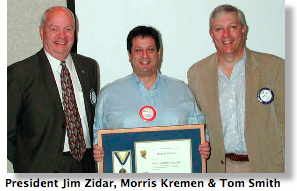
 Jim Zidar gave us a reminder about the importance of clean water with a story:
Jim Zidar gave us a reminder about the importance of clean water with a story:  [Brian is currently in Atlanta. After working for American Water, four weeks ago he took a job with Siemens Water Technologies Corp.] I will remain in Atlanta for now, as will air travel a lot around U. S. to work with their 23 regional sales offices and personally be responsible for all of their effort in large water projects for the electric utility industry. I think this as a much better fit and I am liking it much more already. I may be able to relocate to the NW in 3-5 years with them to work their Pacific Rim business.
[Brian is currently in Atlanta. After working for American Water, four weeks ago he took a job with Siemens Water Technologies Corp.] I will remain in Atlanta for now, as will air travel a lot around U. S. to work with their 23 regional sales offices and personally be responsible for all of their effort in large water projects for the electric utility industry. I think this as a much better fit and I am liking it much more already. I may be able to relocate to the NW in 3-5 years with them to work their Pacific Rim business.